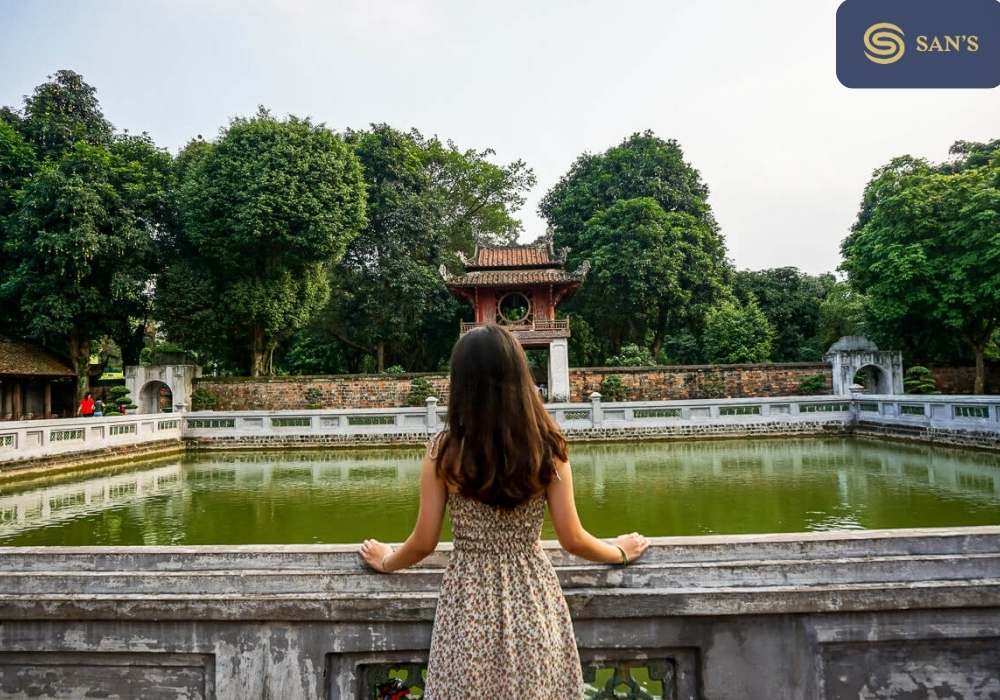Nestled in the heart of bustling Hanoi stands an oasis of tranquility and wisdom – the Temple of Literature. As one of Vietnam’s most iconic landmarks, this temple isn’t merely an architectural masterpiece; it stands as a beacon of the nation’s profound reverence for knowledge, scholars, and its age-old educational traditions.
Founded in 1070 under the Ly Dynasty, the Temple of Literature has the distinguished honor of being Vietnam’s first national university. Originally dedicated to Confucius, the sage of sages, it soon became the epicenter of learning, where Vietnam’s brightest minds congregated to study the principles of Confucianism, literature, and poetry.
-

Temple of Literature
More than just bricks and mortar, this temple-university symbolizes Vietnam’s undying commitment to intellectual pursuits. In an age where temples were primarily devoted to kings and deities, the Temple of Literature was a forward-thinking deviation, shining a spotlight on scholars and their monumental contributions to society.
Over the course of its illustrious history, it has seen the rise and fall of dynasties, survived wars and reconstructions, yet its core ethos remains unchanged: a deep-rooted respect for knowledge. Today, as we embark on a journey through its hallowed corridors, let’s delve deeper into what makes the Temple of Literature an unparalleled symbol of Vietnam’s academic and cultural heritage.
Historical Foundations
In the heart of Hanoi, amid the city’s pulsating rhythms, lies an enduring testament to Vietnam’s intellectual and cultural past: the Temple of Literature. Its establishment in 1070 by Emperor Ly Thanh Tong was not merely an architectural endeavor but a profound statement of the nation’s priorities and values.
-

Temple of Literature
Purpose of Establishment: At its core, the Temple of Literature was conceived as a homage to the teachings of Confucius, the revered Chinese philosopher whose ideas on morality, propriety, and social harmony had resonated across many East Asian cultures. But beyond this homage, there was a more utilitarian and visionary goal. Vietnam, under the Ly Dynasty, recognized the importance of an educated bureaucracy in the administration of the nation.
The Temple, therefore, soon transformed into Vietnam’s premier academic institution, Quoc Tu Giam or the “Imperial Academy”. Here, deserving students, hailing from various regions, received formal instruction, grooming them to become civil servants and scholars, driving the nation forward with their wisdom and integrity.
The Confucian Connect: Confucianism, with its emphasis on ethics, familial respect, and societal order, found fertile ground in Vietnam. Its teachings, which advocate the betterment of the individual as a pathway to societal progress, resonated deeply with the Vietnamese ethos. The Temple of Literature became the focal point of this philosophical adoption.
Majestic altars were dedicated not just to Confucius but also to his disciples and other notable scholars, emphasizing the value the Vietnamese placed on the quest for knowledge. The Temple’s design itself, with its serene courtyards and reflective pools, embodies Confucian ideals of balance, order, and harmony.
As centuries rolled on, the Temple became more than just an educational hub. It evolved into a sanctum where Vietnamese culture, influenced by Confucian values, flourished. The tradition of honoring top scholars with stelae, stone tablets placed on tortoises, began, creating a tangible record of academic excellence and achievement.
Architectural Brilliance
Amidst the clamor of Hanoi’s streets, the Temple of Literature stands as a serene reminder of Vietnam’s architectural genius. This bastion of learning, with its vast expanse and intricate designs, showcases a harmonious blend of functionality, symbolism, and beauty.
-

Temple of Literature
The Quintessential Quintet – The Five Courtyards: Stretching across the Temple’s sprawling premises are five distinct courtyards, each serving a unique purpose and embodying a different facet of the academic journey.
- The First Courtyard: A vast, open expanse, this area, flanked by walls, serves as the entrance. With its serene ponds and ancient trees, it invites visitors into a realm of tranquility and reflection, setting the tone for what lies ahead.
- The Second Courtyard: Home to the majestic Constellation of Literature Pavilion, this space was once the focal point for ceremonial events, underlining the temple’s commitment to knowledge and the arts.
- The Third Courtyard: Dominated by the Thien Quang Well, a large rectangular pond, and the Stelae of Doctors on either side, it serves as a tribute to academic excellence.
- The Fourth Courtyard: The heart of the temple, this is where scholars once underwent rigorous examinations. Today, it houses the main worship hall, dedicated to Confucius and his most eminent disciples.
- The Fifth Courtyard: The newest addition, rebuilt in 2000, pays homage to the Quoc Tu Giam’s legacy as a premier academic institution. It houses statues of prominent Vietnamese scholars, celebrating their contributions.
Structural Significances:
- Quoc Tu Giam Building: Originally the ‘Imperial Academy’, this edifice represents the temple’s academic core. With ornate designs, it served as classrooms and living quarters for the scholars, fostering an environment of rigorous learning and contemplation.
- Stelae of Doctors: Perhaps among the most iconic features, these 82 stone stelae, mounted on tortoises, carry the names of scholars who excelled in the royal exams. Beyond mere record-keeping, they emphasize the nation’s respect for academic achievement.
- Main Worship Hall: With its majestic wooden beams, intricate carvings, and altars, this hall stands as a spiritual epicenter. It’s where the teachings of Confucius, intertwined with traditional Vietnamese values, come alive.
A Blend of Tradition and Craftsmanship: The Temple’s architectural style is a testament to Vietnam’s aesthetic sensibilities. Traditional elements, such as the use of wood and tiles, multi-layered roofs with upturned corners, and the extensive use of red and gold, embody Vietnamese traditions. But beyond the physical, there’s a philosophical alignment. The balance between open spaces and built structures, the emphasis on harmony with nature, all reflect Confucian and traditional Vietnamese beliefs.
Conclusion
The Temple of Literature, with its tranquil courtyards and time-worn stelae, is not just an architectural gem; it’s a pulsating heart in the vast body of Vietnam’s cultural heritage. As we’ve journeyed through its corridors, from its inception as a homage to Confucius to its illustrious days as the nation’s premier academic institution, one truth stands unshaken – the Temple is an embodiment of Vietnam’s undying reverence for knowledge and its scholars.
-

Temple of Literature
Beyond the stone and timber, it’s a chronicle of dreams, aspirations, and relentless pursuits. It tells tales of scholars who toiled under lanterns, of royal examinations that shaped destinies, and of a society that placed knowledge on the loftiest pedestal. In the modern hustle, such places of reflection and reverence are rare, making the Temple an invaluable treasure.
To you, dear reader, the journey doesn’t end with these words. The Temple of Literature beckons. It invites you to walk its ancient pathways, to touch the centuries-old stelae, and to feel, firsthand, the weight and wonder of Vietnam’s historical and academic milestones. So, let this not be an end, but a beginning. Venture forth, immerse yourself, and let the Temple’s enduring spirit inspire and enlighten your soul.
FAQs: Temple of Literature, Hanoi
-

Temple of Literature
- What is the Temple of Literature?
The Temple of Literature, also known as Văn Miếu, is a historic temple complex in Hanoi, Vietnam. Established in 1070, it originally served as a temple dedicated to Confucius. Later, it became Vietnam’s first national university. - Why is it called the “Temple of Literature”?
The name stems from its dual function: it was both a temple dedicated to Confucius, a philosopher who emphasized the importance of education, and a place of study for Vietnam’s elite scholars. - Can anyone visit the Temple of Literature?
Yes, the Temple of Literature is open to the public and is a popular tourist attraction. Visitors can explore its historic courtyards, pavilions, and halls. - Are there any notable features to look out for?
The Temple is known for its serene five courtyards, the Stelae of Doctors (stone tablets mounted on tortoises with names of scholars), and traditional Vietnamese architectural elements. - How are the royal examinations conducted at the Temple significant?
The royal exams, conducted at the Temple, were triennial tests that scholars undertook to secure governmental roles. Success in these exams was considered a high honor, with scholars’ names etched on the Stelae of Doctors. - Has the Temple’s function changed over the years?
Yes. While it began as a center for Confucian learning and later became an academic institution, the Temple eventually transitioned into a place of worship and cultural preservation after the university functions ceased. - How do I get to the Temple of Literature?
The Temple of Literature is located in the Dong Da district of Hanoi and is easily accessible by taxi, bus, or motorbike. - Is there an entrance fee?
There is typically a nominal entrance fee for visitors, but it’s advisable to check current rates and timings before planning a visit. - Can I attend any cultural events or ceremonies at the Temple?
Occasionally, cultural events, ceremonies, and traditional performances are held at the Temple. It’s best to check their events calendar or ask local guides for details. - Why is the Temple of Literature significant in Vietnamese culture?
The Temple symbolizes Vietnam’s long-standing respect for education, scholars, and its cultural heritage. It stands as a testament to the nation’s historical dedication to academic and intellectual pursuits.





